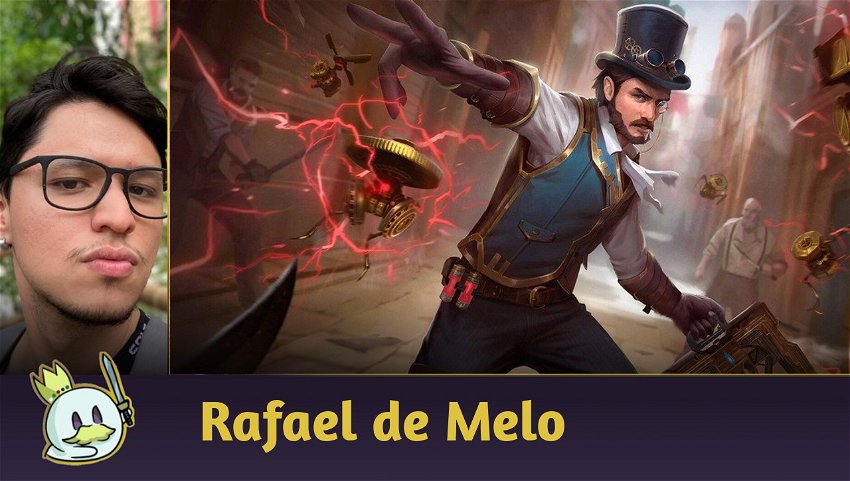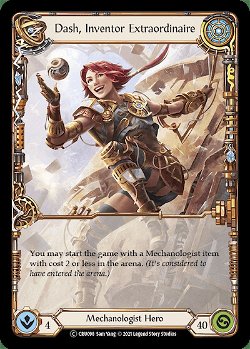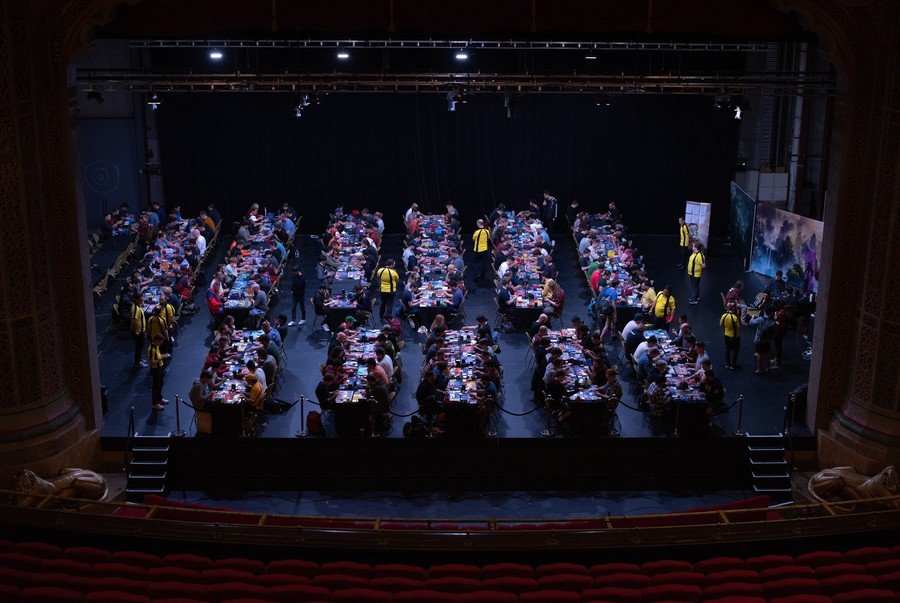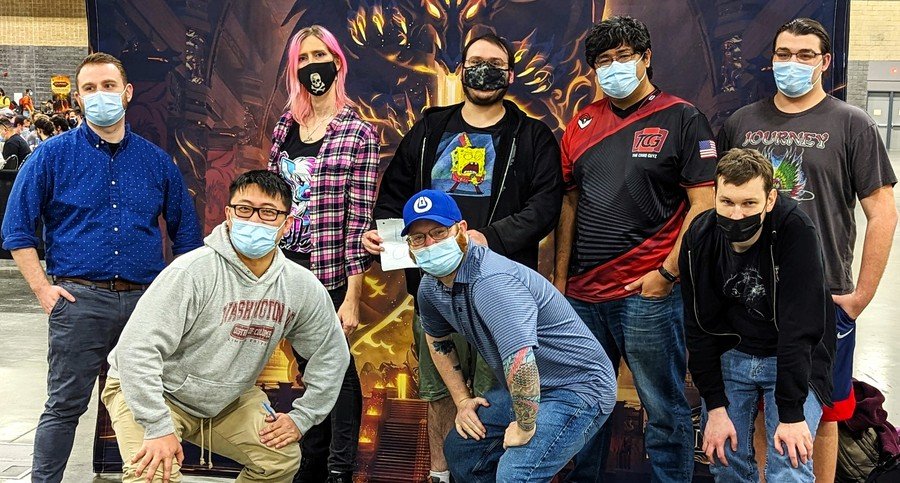Introduction
Flesh and Blood has been in Brazil for approximately four months now, and in the meantime the game has already shown its strength and how successful it is being here, with the announcement of major events for 2023. It was natural (and still is) many stores and players promoting and playing the Blitz format (or Commoner, which is more casual and cheaper). However, the main competitive format of the game is Classic Constructed, and the tendency is for many players to migrate from Blitz to this format.
Classic Constructed is a format that has a larger deck building, more card copies and a sideboard, in addition to adult versions of heroes. Due to these increments, the format ends up differentiating itself from Blitz, which is faster and with different strategies.
Due to their differences, decks in Classic Constructed can follow different and/or empowered ideas from their versions in Blitz, and today we'll talk about one of these heroes that plays identically to Blitz, but has a stronger and also an entirely different plan in Classic Constructed. Today we're going to talk about Dash, Inventor Extraordinaire!

If you don't know the heroine, the Mechanologist class and what she does, I recommend you to read the article about her Blitz deck.
Dash's Approaches

Although in Blitz Dash deck it always starts with Teklo Pounder and is aggressive in every game, in Classic Contructed, she is not restricted to that game plan.
The aggressive approach is still present, being one of the ways the heroine plays, but there are still three more approaches: the control, the control / combo with Construct Nitro Mechanoid and the hybrid.
The control approach involves playing to fatigue the opponent, using generic cards like Sigil of Solace (1) and Sink Below (1) while growing in power and attacking multiple times with Teklo Plasma Pistol. The combo approach holds the game until you meet the Construct Nitro Mechanoid requirements, make the "Megazord" and attack several times with High Octane.
As the aggressive approach is worse against control decks and the control approach is not so good against extremely aggressive decks, then there is the hybrid approach, which seeks to use the best of both worlds, adopting a posture depending on the opponent.
Our opponent is a Fai, Rising Rebellion? We start with Teklo Pounder and try to do as much damage as possible. Is the opponent a Bravo, Showstopper? We hold the game until we increase the power of the pistol and attack several times with it.
As the hybrid approach is the one that appears most in large events and presents excellent results, it is the one that we will discuss today.
Decklist - Hybrid Dash
This list is the one I've been using in my games, and it doesn't deviate much from the idea of the other hybrid lists. Some others may have variance between cards like Tome of Fyendal and Reinforce the Line (1), but let's pay attention to the cards on this list.
To better comment on the list, we will separate it into three parts: The essentials, the aggro package and the control package.
The Essentials
The essentials are the cards that we don't take from the deck in any match, since they have everything we need: strong attacks for aggressive matchups and a good defense (note that all non-item cards defend for three) and several blue cards for defensive matchups.

Some cards will always be played regardless of the game posture. Teklo Core is an excellent item to keep on the field because it grants two extra resources during two turns - allowing you to block with a blue card from your hand without losing the firepower of the turn, in addition to being a blue pitch.
Spark of Genius is the tutor, which has its importance because the deck has several items - mainly in the pistol plan. When we are attacking, we can use it at the end of a Combat chain tutoring Teklo Core, draw a card and put it in the arsenal, thus building a next turn of five cards and two extra resources.
Teklo Pounder might be useless against defensive matchups, but the item is a blue pitch that will always be welcome, and against aggressive matches it's a great item to compete damage with the opponent. It is the starting item when we want to have as much damage as possible in as few turns as possible.

Bios Update, in addition to increasing the power of the next attack, gives us an ability identical to Data Doll MKII. The main objective is not to take full advantage of this ability, but when it puts an item on the field, it is a high value that a zero resource card gives us, but the reason it is on the list is power to increase our attacks.
High Octane is one of the deck's main win conditions. Thanks to this action card, we can circumvent some situations (such as, for example, tutoring an item with Spark of Genius and continuing the turn) but the main reason for its presence on the list is due to the weapon Teklo Plasma Pistol.
As the weapon doesn't have the “Once per turn action” clause, we can attack with it several times in the turn - as long as we have enough resources and action points. Blue pitches give us the resources, and High Octane gives us the action points. We call this the “High Octane Turn”, where we will start with High Octane, use two to three boosted attacks and attack with the pistol three or four times, totaling high damage output.
The card may not look very incredible on the control plan, but at the beginning of the game it replenishes itself and at the end of the game (where generic cards are already scarce) we can go for the boost, increase the pistol's damage and attack several times with it.

Zero to Sixty (1), Zipper Hit (1), Throttle (1), High Speed Impact (3) and T-Bone (3) are our basic cards to do what the deck wants to do: attack with their red versions or use their blue versions as pitch. They don't have specific functions, they are just part of the basics that the deck needs.

Pulsewave Harpoon is one of the few disruption cards the class has. In a Combat chain where this will be your third attack, the chance of you "pulling" an opponent's card is very high, being excellent for taking key cards such as Channel Mount Heroic, Mauvrion Skies (1) , Lava Burst, Mugenshi: RELEASE, Invoke Kyloria among many other examples. This makes it the best Dysnasty card for the class.
Meganetic Shockwave is here mainly because it's a blue pitch, but when well-placed at the end of the Combat chain it can be a nightmare for the opponent, where we can take it away and break important equipment like Fyendal's Spring Tunic, Crown of Providence, Mask of Momentum, New Horizon among others - as well as forcing other equipment with "Temper" or "Battleworn" to lose one defense.
Aggressive Package
Here we are going to deal with the aggressive cards, where they will be included when our plan will be to compete for damage against the opponent.

High Speed Impact (1) and Combustible Courier (1) are the few on-hit effects the deck has. Both are excellent for starting the Combat chain and will most likely be blocked, but with a power boost given by Teklo Pounder, it can take some cards from the opponent.
T-Bone (1), in addition to being a zero cost attack that helps to grow the Combat chain, it forces the opponent to block with an equipment that can be useless against certain heroes, but against others where all their equipment defend, like Warriors, is a tool to take one of these equipment's defense.
Finally, the package also has two important Combat chain finishers: Payload (1) and Maximum Velocity.

Maximum Velocity requires preparation to be played and can spend several turns in the armory (which can slow you down), but when fitted with ten damage it can take the opponent off-guard. Unlike Blitz where having the armory stuck and lower health can be punishing, here in Classic Constructed we have the luxury of using a few turns to prepare it and play a high damage turn.
Payload (1) is easier to use and Dominate can guarantee extra damage or even lethal damage in the match. Several lists don't use it, but I particularly like it because it can also break Phantasm attacks from Dromai, Ash Artist.
Defensive Package
In certain matchups, using this plan may not work, since the opponent can lead us to fatigue. For these cases, the deck transforms and uses a defensive plan focused on the pistol. Since this approach is different from the one used by Dash in Blitz, let's take a closer look at how this plan works.
Pistol Items
When we analyze the Dash decklists, Teklo Pounder and Teklo Core appear very frequently, but these are not the only ones that the class can use, and we will discuss two of them: Induction Chamber and Plasma Purifier.

Induction Chamber was the class's favorite item before Everfest (where Teklo Pounder came from). Its dynamics are identical to those of the pistol: it is not necessary to pay a resource to activate its effect, but we need to pay to put a counter on it and thus activate the effect.
This allows us to place a counter when we have spare resources, and it will stay on the item until we want to use it. With this item on the field, we can, with just one blue pitch, deal four damage with the pistol in the following order:
Pistol Counter > Induction Chamber Counter > Pistol Attack > Give it go again using the item > Pistol Counter > Pistol Attack
With that line alone, Dash can be more defensive and turn any blue pitch into four damage, but of course, the plan won't be restricted to that. Plasma Purifier also works identically, but its ability grows the pistol's power for the entire turn.
So, the objective here is to put some copies of Induction Chamber and Plasma Purifier on the field, charge them up and transform a simple weapon with two power into a weapon with up to five power and that attacks several times.
Pistol Math
So, we have two different items that we can both start in-game and tutor with Spark of Genius, but which one should we start with and which one should we tutor when we can?
If you've drawn the item, you'll play it regardless of what it is, but I'd like to show you a little math here and see what the maximum damage Teklo Plasma Pistol can deal with different combinations of items.


The first table shows the different item combinations and how much damage the pistol can deal, assuming we'll have enough resources for that, while the second shows the amount of resources needed to carry all the items and pistol to deal that damage. For example: with one Induction Chamber and two Plasma Purifier, the maximum damage will be eight and that will cost you five resources.
So, we want to follow a sequence that makes the most of the damage in the most efficient way. Analyzing the tables, we arrive at the following sequence:
Chamber > Purifier > Chamber > Purifier > Purifier
Since the list doesn't have the third Induction Chamber, the maximum damage we can deal will be fifteen. Keep this sequence in mind and, if any of these items are done out of sequence, try to correct this difference with the next one you put in the field.
We conclude here, too, that the best item to start with is Induction Chamber for this plan.
Generic Cards
For this whole plan to work, we need time and ways to protect ourselves, and for that, we put some generic defense reactions to keep our health high while we prepare the items.

Sink Below (1) and Fate Foreseen (1) are among the best defense reactions in the game. While Fate Foreseen (1) allows us to manipulate the top, Sink Below (1) can fix our hand by exchanging a card from it. Unmovable (1) helps hold off bigger attacks or on-hit effects that can slow us down.
Remember, then, that we want to hold as much damage as possible in the first few turns, prepare the pistol items and, in the mid-end game, start dealing high damage with the weapon. Here our blue cards are critical to carry all these items, so we must protect ourselves using essentially the red and yellow cards - since we will rarely play them.
Equipment
With the high density of cards on the sideboard, there are few slots left for equipment, but that doesn't mean they will be less relevant.

As explained extensively so far, the weapon will be Teklo Plasma Pistol. Considering another weapon will involve a change in both deck approaches and won't be used on this list, but I'll mention them for knowledge.
Hanabi Blaster can be a weapon alternative to the other aggressive plan that involves using Hyper Driver (1) and various cards that support this item. The other two possible weapons, Talishar, the Lost Prince and Plasma Barrel Shot, are rarely used in Classic Constructed, being more relevant in Blitz.

In the head, we will vary between two equipments.
Crown of Providence will be chosen in almost every game. In addition to defending two, its ability is what makes it so strong, being able to protect a card from your arsenal from a Command and Conquer, add a fifth card to your hand to defend better or correct a bad hand.
Another equipment that can be played instead is Arcanite Skullcap for the possibility of defending up to three, but I don't see the need for a place on the sideboard to accommodate both equipment, so run one or the other, whichever you think is best for your Metagame.
Against Wizards, we will equip Viziertronic Model i for having Arcane Barrier 2. Its ability may even be relevant to fix hands with bad attacks, but it is on the sideboard exclusively for arcane protection. Coupled with the feet equipment, then we have a total of three arcane prevention, which is enough in my view.

Our chest will always be Teklo Foundry Heart. Legendary equipment gives us an extra resource in exchange for two deck cards. As if that weren't enough, it also defends up to three attacks without breaking (due to the Battleworn), making it an excellent and essential piece of equipment on the list.

For the hands, two options are used: Goliath Gauntlet and Galvanic Bender. The lists generally run Goliath Gauntlet. However, I particularly like Galvanic Bender in most games and the other equipment against Wizards or games that I will compete for damage.
Although in this deck it does the same job as an Ironrot Gauntlet, having this defense can be important to take the value of blocking a Snatch (1), for example, but using only Goliath Gauntlet is good enough too.

On the feet, we will only run Achilles Accelerator. In addition to Arcane Barrier 1 (which is very useful against Runeblades and, as mentioned, against Wizards) its ability allows you to gain one more action point and continue the turn if you don't want to pay the cost of Blizzard, continue the turn after a Spark of Genius and so on.
Pros and Cons
Dash, Inventor Extraordinaire can be extremely flexible in its game plan depending on the opponent, thus making any match with real chances of winning, but wanting to have both stances makes them weaker than their pure versions. We couldn't be the best aggressive version that Dash can offer, nor the best control.
In addition, several of the attacks we have are vanilla (vanilla cards are those that don't have any relevant abilities and/or effects) with few on-hit attacks, this ends up making their attacks without relevant effects, but cards like Pulsewave Harpoon and Meganetic Shockwave are so good that they can end making up for that.
Sideboard
As mentioned, the deck is divided between essential, control and aggressive. Soon, you'll start with the deck's essentials plus some of the two packages. We can use the following shortcuts when building the deck for the match:
-> Essential + Control: against Oldhim, Grandfather of Eternity, Bravo, Showstopper (because they are Guardians and can lead you to fatigue), Dorinthea, Ironsong (because we need Defense reactions to avoid Dawnblade as much as we can) and Arakni, Huntsman (since it can exile the top of your deck, it accelerates your fatigue).
-> Essential + Pistol items only: against Dromai, Ash Artist (to kill dragons with the pistol while still being aggressive) and mirror (since we don't know the other Dash's plan, it's good to keep a combination to take the necessary posture).
-> Essential + Aggressive: other heroes in the game.
Against midrange decks, instead of starting with Teklo Pounder, we can choose to start with Induction Chamber to have a better mid/late game.
Conclusion
Dash, Inventor Extraordinaire is an extremely flexible heroine and has been gaining more and more space in major competitive events, having representation in the TOP 32 of the most recent Callings and the big winner of Calling Auckland. So if you are eager to join Classic Constructed with a simple, flexible deck with a great position in the Metagame, Dash might be your heroine.
Thanks for reading this far, and until next time.















— Комментарии 0
, Реакции 1
Прокомментируйте первым